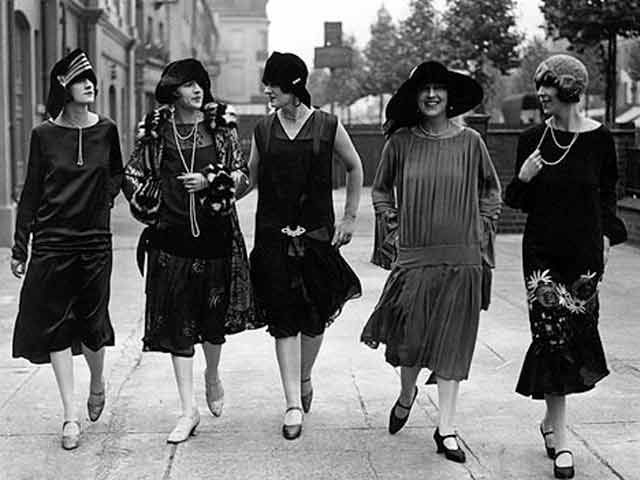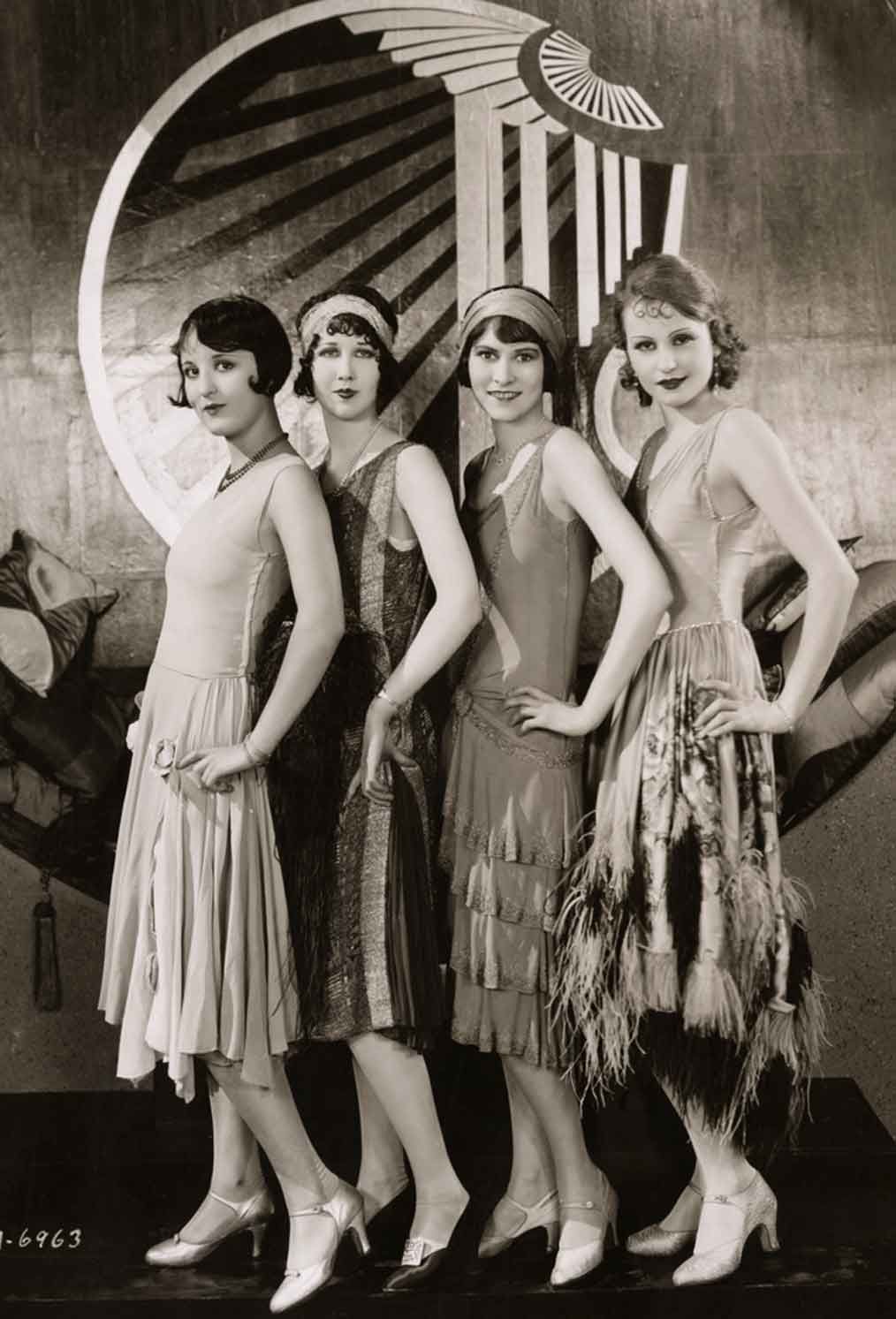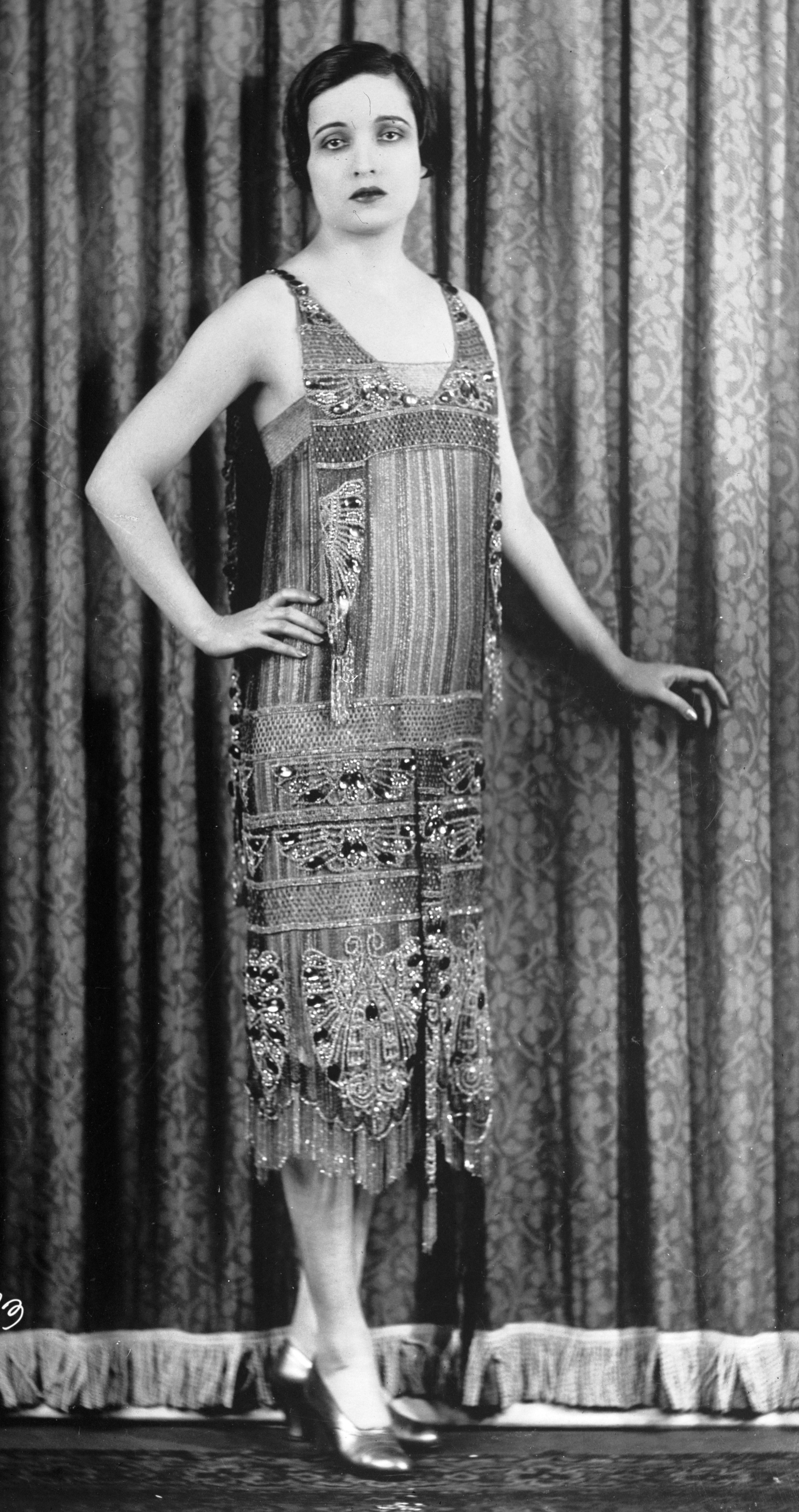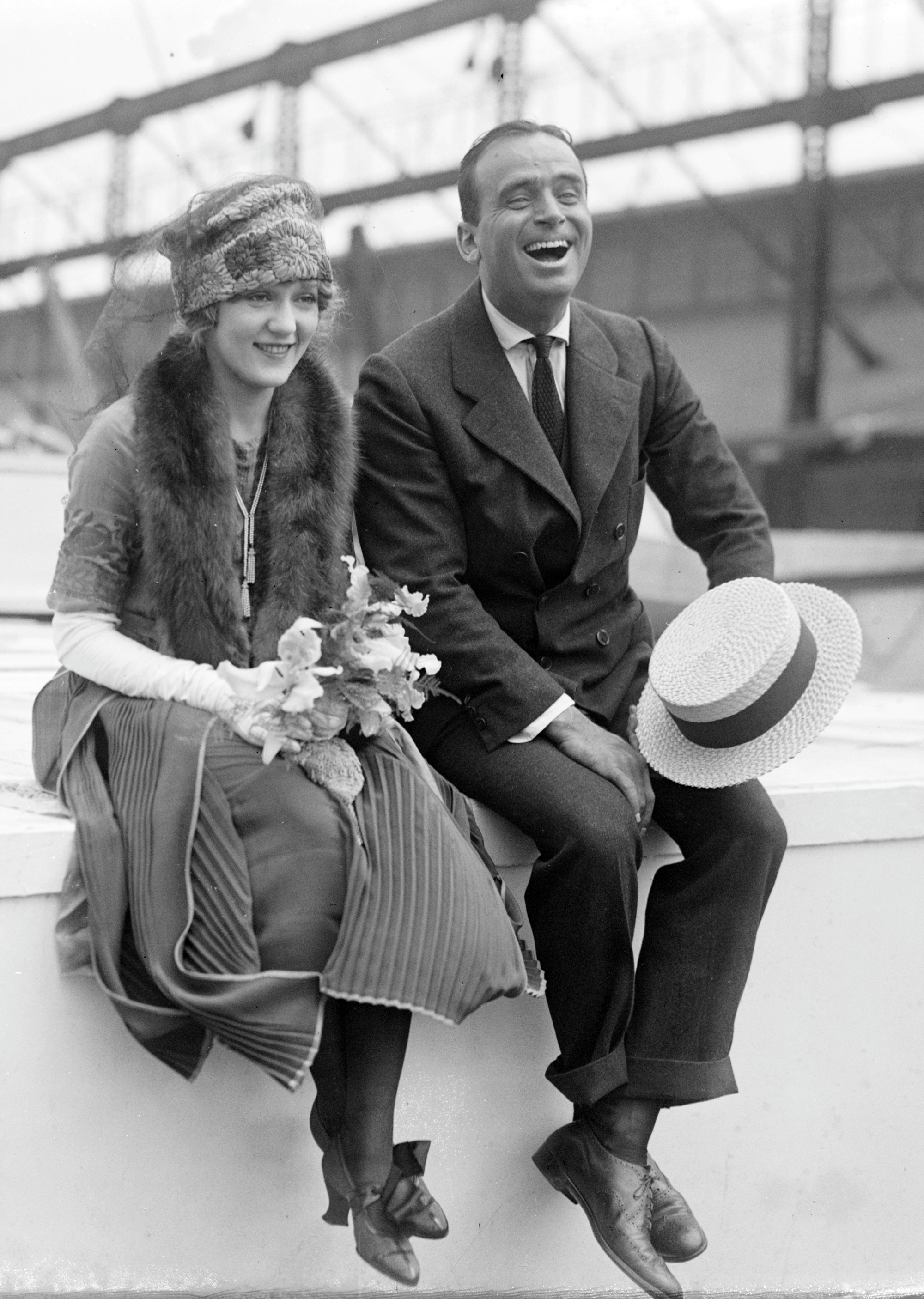Prvi svjetski rat je završio, a u svijetu je zavladala euforija. Kako je moda odraz svega što se događa oko nas tako je i na novu slobodu moda odgovorila promjenama. Haljinama je pao struk do razine kukova i prestale su pratiti liniju tijela. Novi trend je težio ka jednostavnosti, prsluci su jednostavni, oblikovani koristeći samo nekoliko nabora na ramenima ili bočnih šavova. Na početku novog desetljeća rubovi suknji su se pojavili iznad gležnja, a u samo tri godine duljine suknji su se popele na do tada neviđene visine.

Izrezi oko vrata su većinom bili jednostavni okrugli ili “V”. Rukavi su bili dugi i ravni ili u obliku zvona. Na nekim haljinama pojavljuje se i remen na bokovima, a haljine i u tom slučaju padaju u ravnoj liniji. Među tkaninama prevladavali su šifon, lagana svila, mekani baršun, laganija vuna i mekani pamuk. Haljine su bile jednostavnog kroja, a detalji su prevladavali na površini. Detalji kao što je vez, meka pletenica i perlice za navečer ili pak manipulacije tkaninama poput naboranog šivanja na mašinu ili štirkanja. Na plesnim podijima posebno su bila popularne prozirne i polu-prozirne haljine sa pripadajućim gaćicama.

Razdoblje oko 1920-te godine nazivaju još i “era laskanja” („flapper era“ – o toj temi budem još pisala). Do 1926 rubovi haljina nastavili su svoj skandalozan uspon i stigli do koljena. Nizak struk i dalje je uživao popularnost, ali suknje i prsluci postali su sve složeniji zahvaljujući šavovima, kružnim volanima i lepršavim materijalima. Počeli su se pojavljivati ukrasni šalovi, kontrastne tkanine i slojevi. Ručno nizanje perlica koje je iziskivalo puno vremena i novca bilo je iznimno popularno, a posebno za plesne haljine.
Razine suknji, koje su neki smatrali nepristojnima, pripitomljene su modnim kolekcijama iz 1928./1929. godina, dok su asimetrični rubovi (duljina haljine na u prednjem dijelu do koljena, a duže na leđima) svojom pojavom najavili duže rubove u razdoblju 1930-tih godina. Struk se postupno podigao na razinu koju mu je priroda namijenila.

Dizajneri 20-tih godina su bili: Patou, Molyneux, Chanel, Boue Souers, Louiseboulanger, Augustabernard and Vionnet.
Zagreb je 20-tih također reagirao na svjetske trendove i bio grad slobodnih žena. Zagrepčanke toga vremena vjerno su slijedile europske trendove u modi i životnom stilu, te prigrlile žensku emancipaciju. U “ludim 20-ima”, kako se često naziva ovo doba (doba art decoa), žene su skratile suknju, odrezale kosu i počele pušiti, često i lule, nositi bubikopf frizuru, a s rezanjem kose odbacile su i stari svjetonazor, te postale promotori novog duha vremena. Procvali su i modni saloni.

Mnoge dame odrekle su se elegantne, skupocjene odjeće i odjenule kratke ravne haljine bezstruka, odrezale kosu i ogrnule se muškim jaknama. Rođena je nova smjela žena, kaže, i izgledom i ponašanjem. Fenomen “garçonne” najavljivao je mobilnost, brzinu i funkcionalnost novoga stila života, a ujedno je predstavljao ženu kao glavnu potrošačicu novoga doba. Žene su prihvatile i smoking i muške pidžame širokih nogavica, od svile, koje su nosile na plaži i kod kuće, a one smjelije i na ulici. Smoking kao senzacija nove mode predstavljen je u časopisu Svijet 1926. godine 20-ih godina počinje i opća holivudizacija, te opčinjenost ženskom ljepotom, što je rezultiralo da su sve popularnija natjecanja za miss.
FASHION IN THE PERIOD 1920 – 1930
With the end of the First World War, the world was gripped by euphoria. Since fashion is a reflection of what is happening around us, and so fashion responded to changes of this new found freedom. Dresses dropped their waist to the hip level and they ceased to follow the line of the body. The new trend was aiming toward simplicity, waistcoats were simple, shaped by using only a few creases on the shoulders or side seams. At the start of the new decade, skirt edges appeared above the ankle, and in just three years, the length of the skirt climbed to hitherto unseen heights.
Cuts around the neck were mostly simple round or “V.” The sleeves were long and straight or bell-shaped. On some dresses a strap on the hips appeared, and dresses in this case were falling in a straight line. Chiffon predominated among the fabrics, light silk, soft velvet, lighter wool and soft cotton. Dresses were cut simply, and the details were prevalent on the surface such as embroidery, soft braids and beads for the evening or manipulation of fabrics like pleated sewing on a machine or starching. Transparent and semi – transparent dresses with associated trunks were particularly popular on the dance floor.
The period around the year 1920 is also called the “era of flattery” (“flapper era” – on this subject I have yet to write). By 1926 the dress edge had continued their scandalous rise and had reached the knee level. The low waist still enjoyed its popularity, but skirts and waistcoats had become increasingly complex due to the seams, circular ruffles and flowing materials. Decorative scarves began to appear, contrasting fabrics and layers. Manual stringing of beads, which required a lot of time and money, was extremely popular, especially for dance dresses.
Skirt levels, which were sometimes considered indecent, were domesticated fashion collections from 1928/1929, while the asymmetric edges (dress lengths on the front side to the knee, and more on the back) announced with their appearance longer edges in the period of the 1930s. Waist was gradually raised to a level that the nature had intended for it.
The designers of the 1920s were: Patou, Molyneux, Chanel, Boue Souers, Louiseboulanger, Augustabernard and Vionnet.
During the 1920s, Zagreb also responded to the global trends, and was a free woman’s city. The women of Zagreb of that time faithfully followed European trends in fashion and lifestyle, and embraced the women’s emancipation.
In the “crazy 20s,” as this era was often called (era of the art deco), women shortened their skirts, cut their hair and began to smoke, often even pipes, wore bubikopf hair, and with the cutting of their hair they rejected the old worldview, and became promoters of the new spirit of the times. New fashion salons flourished as well.
Many ladies gave up on the elegant, expensive clothes and began wearing straight short dresses without the waist, they cut off their hair and covered themselves with the men’s jackets. The new, bold woman was born, both in appearance and behavior. The phenomenon of “garçonne” announced the mobility, speed and functionality of the new lifestyle, and it also represented the woman as the main consumer of the new era. Women accepted the tuxedo and men’s pajamas with baggy pants as well, made of silk, which were worn on the beach and at home, and the brave ones even on the street. Smoking as the new fashion sensation was featured in the magazine World in 1926. In the 1920s, the general hollywoodization and fascination with the female beauty began, which resulted in the popularization of beauty pageants.
MODE IM ZEITRAUM VON 1920 – 1930
Der erste Weltkrieg ist vorbei, weltweit herrscht Euphorie. Da die Mode alles reflektiert, was um uns passiert, so kam es auch bezüglich der neuen Freiheit zu bestimmten Änderungen in der Mode. Die Kleidertaille fiel bis zu den Hüften und es wurde nicht mehr die Körperlinie verfolgt. Neuer Trend war Einfachheit, Westen sind einfach, mit nur einigen Falten an den Schultern oder seitlichen Nahten. Am Beginn des neuen Jahrhunderts fielen die Röcke bis zu den Schenkeln, in nur drei Jahren stiegen sie bis zu bis dahin ungesehenen Höhen.
Halsausschnitte waren meistens einfach rund oder in Form des Buchstaben “V”. Ärmel waren lang und geradlinig oder in Glockenform. So manche Kleider haben Gürtel an den Hüften aber sie fallen auch weiter in gerader Linie. Unter den Materialen dominieren Chiffon, leichte Seide, sanfter Samt, leichte Wolle und sanfte Baumwolle. Kleider waren einfach geschnitten, mit Details an der Oberfläche. Details wie Stickerei, sanfte Flechte und Perlen für den Abend oder doch Manipulationen mit den Stoffen wie faltenreiches Maschinennähen oder Stärken. Auf den Tanzflächen waren durchsichtige oder halb-durchsichtige Kleider mit dazugehörigen Höschen sehr populär.
Den Zeitraum um das Jahr 1920 nennt man auch noch die “Flapper Ära” (über dieses Thema werde ich noch schreiben). Bis 1926 wurden die Röcke immer kurzer und kurzer und kamen bis zu den Knien. Niedrige Taille war auch weiter sehr populär aber Röcke und Westen waren immer komplexer dank den Nahten, Wolant und flatternden Materialen. Es erschienen dekorative Schals, kontrastreiche Stoffe und Schichten. Mit der Hand angebrachte Perlen, wofür viel Zeit und Geld notwendig war, waren sehr populär, vor Allem an Tanzkleidern.
Rocklängen, die manche für unangemessen gehalten haben, wurden mit den Modekollektionen aus den Jahren 1928/1929 angenommen, während asymmetrische Ränder (Kleiderlänge am Vorderteil bis zu den Knien, am Hinterteil länger) mit ihrer Erscheinung lange Ränder im Zeitraum der 1930-er Jahre angekündigt haben. Die Taille kam langsam auf ihre natürliche Position.
Designer der 20-er Jahre waren: Patou, Molyneux, Chanel, Boue Souers, Louiseboulanger, Augustabernard und Vionnet.
Zagreb reagierte in den 20-er Jahren ebenfalls auf die Welttrends und war eine Stadt freier Frauen. Die Bewohnerinnen von Zagreb folgten in dieser Zeit die europäischen Trends in der Mode und im Lebensstil und akzeptierten die Frauenemanzipation.
In den „verrückten 20-er Jahren”, wie dieser Zeitraum oft genannt wurde (Art Deco Zeitraum), kürzten die Frauen ihre Röcke, sie kürzten ihre Haare, begannen zu rauchen, oft auch Pfeifen, trugen Bubikopf Frisuren, mit dem Haareschneiden wiesen sie die alte Weltanschauung zurück und wurden zu Promotorinnen neuer Zeiten. Modesalons blühten auf.
Viele Damen verzichteten auf elegante, teure Kleidung und zogen kurze, gerade geschnittene Kleider ohne Taille an, kürzten ihre Haare und trugen Männerjacken. Eine neue, mutige Frau war geboren, mit Aussehen sowie auch mit dem Verhalten. Das Phänomen “garçonne” kündigte Mobilität, Schnelligkeit und Funktionalität des neuen Lebensstils an, stellte aber gleichzeitig die Frau als die Hauptverbraucherin der neuen Zeit dar. Frauen trugen gerne Smoking und Männerschlafanzüge aus Seide, sie trugen sie zum Strand und zu Hause, die mutigen auch auf der Straße. Der Smoking wurde als die Sensation der neuen Mode im Jahr 1926 in der Zeitschrift Welt vorgestellt. In den 20-er Jahre begann auch die allgemeine Hollywoodiesierung und allgemeine Faszination mit der Frauenschönheit, was zur Popularisierung der Misswahlen geführt hat.


